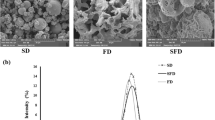Abstract
Properties of instant coffee foam constitute the focus of this study. The coffee, obtained from commercial sources, was dispersed in water at a concentration in the range of standard use. The resulting solution contained a substantial amount of micron and submicron size particles that were filtered with membranes having difference size cut-offs in order to investigate the relationship foam properties—particles size. The foams produced from these solutions have been imaged by confocal laser scanning microscopy, and their moduli and stability have been measured by oscillatory rheology, using an in-house developed rheometric set-up. The results show that particles larger than 0.8 µm have little effect on the reduction of drainage while a clear strengthening effect on the foam was evident. This was a result of their diffusion to the lamellae borders, which increases the viscosity of the liquid–air interface. Particles smaller than 0.2 µm affect bubble coarsening and likely hinder the migration of soluble surface active species to the bubble surface. Particles also participate in the stabilization of the air–water interface, and this affects both the foam stability and mechanical properties. Established models developed for ideal foam systems containing particles are difficult to apply due to the complexity of the system studied. Despite this limitation, these results provide increased understanding of the effect of particles on instant coffee foams.






Similar content being viewed by others
References
Illy E, Navarini L (2011) Neglected food bubbles: the espresso coffee foam. Food Biophys 6(3):335–348
Nebesny E, Budryn G (2006) Evaluation of sensory attributes of coffee brews from robusta coffee roasted under different conditions. Eur Food Res Technol 224(2):159–165
Ferrari M, Navarini L, Liggieri L, Ravera F, Suggi Liverani F (2007) Interfacial properties of coffee-based beverages. Food Hydrocoll 21(8):1374–1378
Piazza L, Gigli J, Bulbarello A (2008) Interfacial rheology study of espresso coffee foam structure and properties. J Food Eng 84(3):420–429
Piazza L, Bulbarello A, Gigli J (2006) Rheological interfacial properties of espresso coffee foaming fractions. In: 13th World congress of food science and technology 2006, pp 873–873
Fischer M, Reimann S, Trovato V, Redgwell RJ (2001) Polysaccharides of green Arabica and Robusta coffee beans. Carbohydr Res 330(1):93–101
Nunes FM, Coimbra MA (1998) Influence of polysaccharide composition in foam stability of espresso coffee. Carbohydr Polym 37(3):283–285
Nunes FM, Coimbra MA (2001) Chemical characterization of the high molecular weight material extracted with hot water from green and roasted Arabica coffee. J Agric Food Chem 49(4):1773–1782
Hunter TN, Pugh RJ, Franks GV, Jameson GJ (2008) The role of particles in stabilising foams and emulsions. Adv Colloid Interface Sci 137(2):57–81
Weaire D, Pittet N, Hutzler S, Pardal D (1993) Steady-state drainage of an aqueous foam. Phys Rev Lett 71(16):2670–2673
Horozov TS (2008) Foams and foam films stabilised by solid particles. Curr Opin Colloid Interface Sci 13(3):134–140
Binks BP (2002) Particles as surfactants—similarities and differences. Curr Opin Colloid Interface Sci 7(1–2):21–41
Bournival G, Ata S, Wanless EJ (2015) The roles of particles in multiphase processes: particles on bubble surfaces. Adv Colloid Interface Sci 225:114–133
Ravera F, Ferrari M, Liggieri L, Loglio G, Santini E, Zanobini A (2008) Liquid–liquid interfacial properties of mixed nanoparticle–surfactant systems. Colloids Surf A Physicochem Eng Asp 323(1–3):99–108
Acknowledgments
The authors would like to thank Dr. Damiano Rossetti for his precious advices and discussion of this paper. The VINN Excellence centre SuMo Biomaterials is acknowledged for financial support.
Author information
Authors and Affiliations
Corresponding author
Ethics declarations
Conflict of interest
The authors declare that they have no conflict of interest.
Compliance with ethics requirements
This article does not contain any studies with human or animal subjects.
Rights and permissions
About this article
Cite this article
Gmoser, R., Bordes, R., Nilsson, G. et al. Effect of dispersed particles on instant coffee foam stability and rheological properties. Eur Food Res Technol 243, 115–121 (2017). https://doi.org/10.1007/s00217-016-2728-7
Received:
Revised:
Accepted:
Published:
Issue Date:
DOI: https://doi.org/10.1007/s00217-016-2728-7




